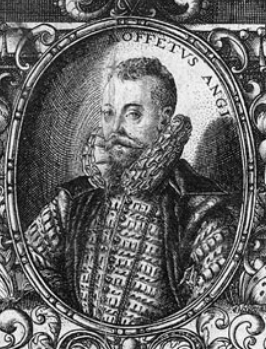Thomas Muffet facts for kids
Quick facts for kids
Thomas Muffet
|
|
|---|---|

Muffet c. 1589
|
|
| Born | 1553 Shoreditch, London, England
|
| Died | June 5, 1604 (aged 50–51) Bulbridge Farm, Wilton, Wiltshire
|
| Alma mater | Trinity College, Cambridge |
| Known for | Insects in medicine |
| Scientific career | |
| Fields | Natural philosophy, medicine |
| Influences | Paracelsus, T. Zwinger |
Thomas Muffet (also spelled Moufet, Mouffet, or Moffet) was an English scientist and doctor. He was born in 1553 and passed away on June 5, 1604. He is famous for his studies of insects and other small creatures, especially how they related to medicine. Thomas Muffet also supported a different way of practicing medicine called the Paracelsian system. He believed that real-world experience was more important than just a doctor's reputation. He also had strong Puritan religious beliefs.
Contents
About Thomas Muffet
His Early Life and School
Thomas Muffet was born in 1553 in Shoreditch, London. His father, also named Thomas Moffet, sold fabrics and clothing. From ages 8 to 16, Thomas Muffet went to the Merchant Taylors' School.
In 1569, he started studying at Trinity College, Cambridge. Later, he moved to another college, Gonville Hall. He earned his first university degree, a bachelor's degree, in 1573. After that, he studied medicine with well-known doctors like Thomas Lorkin and John Caius.
Three years later, he began working on his second degree, a master's degree, at Trinity. In 1578, Muffet lived with Felix Platter, a top doctor in Switzerland. It was here that he learned about and adopted the Paracelsian system of medicine. In 1579, he earned his highest medical degree, a doctorate in medicine, from Basel University.
His Later Life and Work
After getting his medical degree in 1580, Thomas Muffet traveled to Italy. There, he studied silkworms and their bodies. He then returned to England. In December of that year, he married his first wife, Jane.
In 1582, the College of Physicians in London recognized him as a qualified doctor. This was a bit surprising because Muffet strongly supported the Paracelsian medical system, which many doctors at the time did not respect. That same year, a powerful official named Sir Francis Walsingham sent Muffet on a special trip to Denmark. He was to give a special award, the Order of the Garter, to King Frederick. While there, he met famous scientists Tycho Brahe and Petrus Severinus.
In 1584, Muffet wrote a paper called De jure et praestantia chemicorum medicamentorum. This paper talked about new ways of learning and thinking, much like the ideas that Francis Bacon would later become famous for. That same year, Muffet wrote a letter criticizing the London College of Physicians. He believed they were too influenced by certain religious ideas, which went against his own Puritan beliefs. However, the next year, he was accepted into the College of Physicians, becoming a full member in 1588.
Later in 1588, Muffet published another book, Nosomantica Hippocratea. In this book, he supported the ideas and writings of Hippocrates, who is often called the "father of medicine." In 1597, Muffet was chosen to be a member of parliament for Wilton.
In 1600, Muffet's first wife, Jane, passed away. He then married Catherine Brown later that year. Thomas Muffet died on June 5, 1604, at Bulbridge Farm in Wilton, Wiltshire.
His Scientific Discoveries
Studying Insects
Thomas Muffet's interest in insects began when he studied silkworms in Italy. This led to his lifelong fascination with arthropods, especially spiders. He worked on a very important book called Insectorum sive Minimorum Animalium Theatrum (which means "Theatre of Insects"). This book was an illustrated guide to how insects are classified and how they live.
Many people think Muffet wrote the whole book himself, but he actually took over the project from other scientists. He added to their work and helped get it ready for printing. The book included important contributions from three other scientists: Conrad Gesner, Edward Wotton, and Thomas Penny.
The book was ready to be published around 1589 or 1590, but it wasn't printed until 30 years after Muffet died. This was partly because there wasn't a big market for science books in England at that time. The original drawings were too expensive to print, so simpler woodcut pictures were used instead. After Muffet's death, his papers were sold to Theodore de Mayerne, a doctor to King James I. Mayerne finally published the book in 1634. Muffet's original writings for the book are now kept in the British Library.
Ideas on Good Health and Food
Muffet also wrote about healthy eating in his book Health's Improvement. This book was written more for everyday people than for other doctors. It was the first book to list British wildfowl (wild birds). It also recognized for the first time that many birds migrate, meaning they travel long distances at certain times of the year. This book was published even later than his insect book, not until 1655.
Nursery Rhyme Connection
Some people believe that Thomas Muffet is the "Muffet" mentioned in the famous nursery rhyme 'Little Miss Muffet'. They suggest the rhyme might be about something that happened with one of his stepchildren. However, there is no clear proof of this connection. The rhyme itself wasn't printed until 1805, long after Muffet lived.


